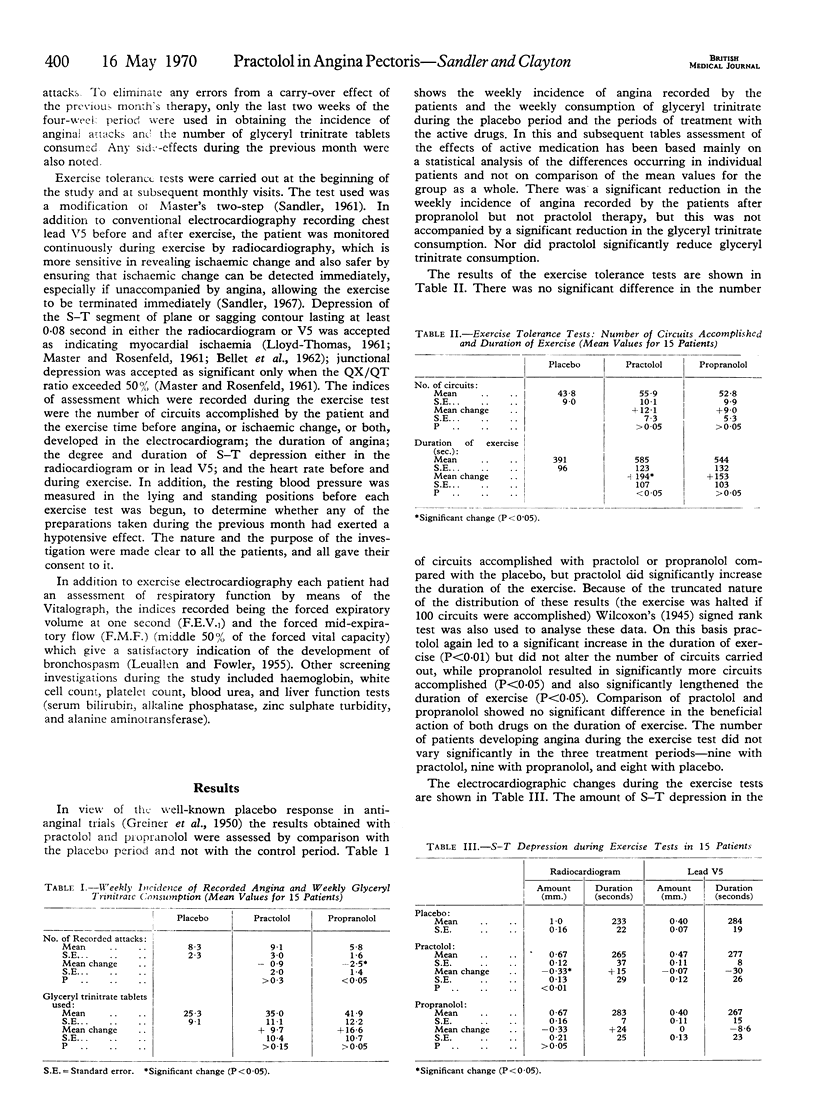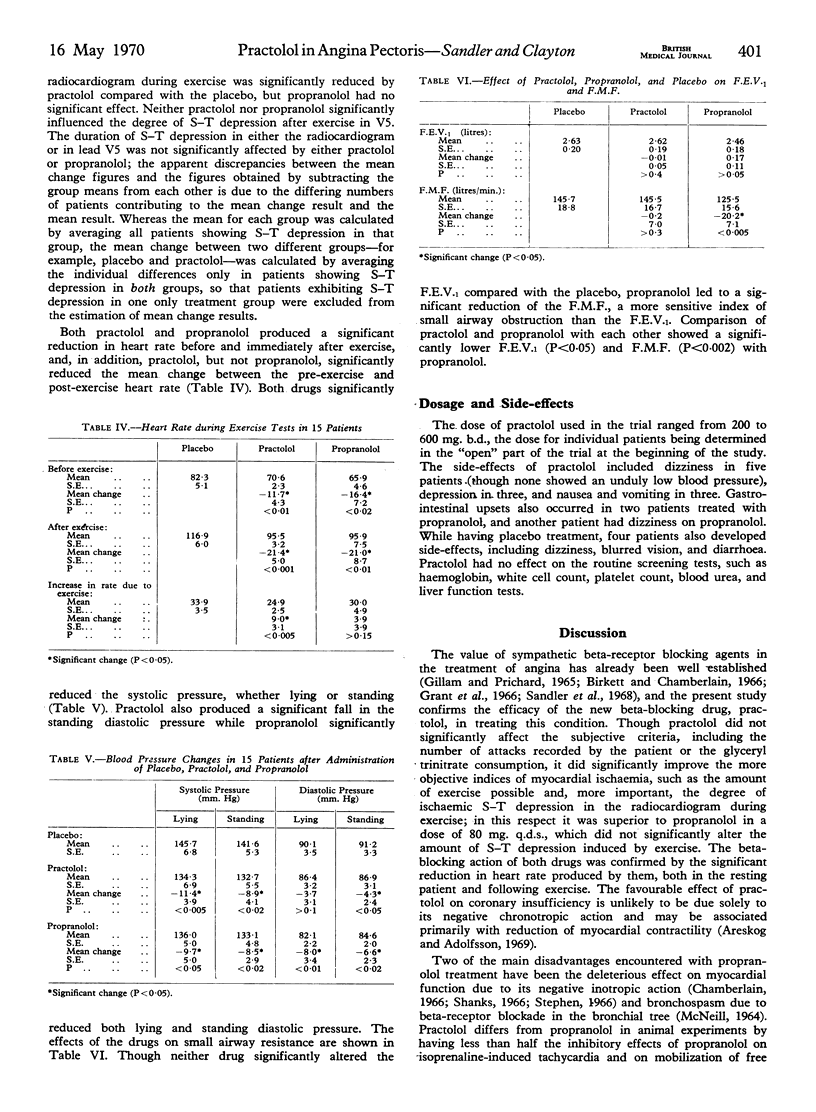Abstract
In a controlled double-blind study practolol, a new cardioselective beta-blocking drug, was given to 15 patients with angina pectoris, and compared with propranolol 80 mg. q.d.s. The dose of practolol ranged from 200 to 600 mg.b.d. and was decided by initial open titration in individual patients. Though practolol did not influence the incidence of angina or glyceryl trinitrate consumption, it increased the duration of exercise possible in exercise tests and reduced the amount of ischaemic S—T depression in the radiocardiogram during exercise. Propranolol reduced the incidence of angina and, in the exercise tests, increased the amount and duration of exercise but did not affect the degree of S—T depression. Unlike propranolol, practolol did not produce any adverse effects on bronchial smooth muscle. Hence it is concluded that practolol is an effective drug in treating angina, and in the dosage used is of potential value in patients with asthmatic bronchitis and angina. It should, however, be used cautiously in anginal patients with heart failure.
Full text
PDF



Selected References
These references are in PubMed. This may not be the complete list of references from this article.
- Areskog N. H., Adolfsson L. Effects of a cardio-selective beta-adrenergic blocker (I.C.I. 50172) at exercise in angina pectoris. Br Med J. 1969 Jun 7;2(5657):601–603. doi: 10.1136/bmj.2.5657.601. [DOI] [PMC free article] [PubMed] [Google Scholar]
- BELLET S., ELIAKIM M., DELIYIANNIS S., LAVAN D. Radioelectrocardiography during exercise in patients with angina pectoris. Comparison with the postexercise electrocardiogram. Circulation. 1962 Jan;25:5–14. doi: 10.1161/01.cir.25.1.5. [DOI] [PubMed] [Google Scholar]
- BLACK J. W., CROWTHER A. F., SHANKS R. G., SMITH L. H., DORNHORST A. C. A NEW ADRENERGIC BETARECEPTOR ANTAGONIST. Lancet. 1964 May 16;1(7342):1080–1081. doi: 10.1016/s0140-6736(64)91275-9. [DOI] [PubMed] [Google Scholar]
- Barrett A. M., Crowther A. F., Dunlop D., Shanks R. G., Smith L. H. Cardio-selective beta-blockade. Naunyn Schmiedebergs Arch Exp Pathol Pharmakol. 1968;259(2):152–153. doi: 10.1007/BF00537746. [DOI] [PubMed] [Google Scholar]
- Birkett D. A., Chamberlain D. A. Beta-adrenergic blockade in angina pectoris: a method of treadmill assessment. Br Med J. 1966 Aug 27;2(5512):500–502. doi: 10.1136/bmj.2.5512.500. [DOI] [PMC free article] [PubMed] [Google Scholar]
- DORNHORST A. C., ROBINSON B. F. Clinical pharmacology of a beta-adrenergic-blocking agent (Nethalide). Lancet. 1962 Aug 18;2(7251):314–316. doi: 10.1016/s0140-6736(62)90104-6. [DOI] [PubMed] [Google Scholar]
- Dunlop D., Shanks R. G. Selective blockade of adrenoceptive beta receptors in the heart. Br J Pharmacol Chemother. 1968 Jan;32(1):201–218. doi: 10.1111/j.1476-5381.1968.tb00444.x. [DOI] [PMC free article] [PubMed] [Google Scholar]
- Fitzgerald J. D., Scales B. Effect of a new adrenergic beta-blocking agent (ICI 50,172) on heart rate in relation to its blood levels. Int Z Klin Pharmakol Ther Toxikol. 1968;1(6):467–474. [PubMed] [Google Scholar]
- GILLAM P. M., PRICHARD B. N. USE OF PROPRANOLOL IN ANGINA PECTORIS. Br Med J. 1965 Aug 7;2(5457):337–339. doi: 10.1136/bmj.2.5457.337. [DOI] [PMC free article] [PubMed] [Google Scholar]
- GREINER T., GOLD H., CATTELL M., TRAVELL J., BAKST H., RINZLER S. H., BENJAMIN Z. H., WARSHAW L. J., BOBB A. L., KWIT N. T. A method for the evaluation of the effects of drugs on cardiac pain in patients with angina of effort; a study of khellin (visammin). Am J Med. 1950 Aug;9(2):143–155. doi: 10.1016/0002-9343(50)90017-9. [DOI] [PubMed] [Google Scholar]
- Gibson D., Sowton E. Effects of I.C.I. 50172 in man during erect exercise. Br Med J. 1968 Jan 27;1(5586):213–215. doi: 10.1136/bmj.1.5586.213. [DOI] [PMC free article] [PubMed] [Google Scholar]
- Grant R. H., Keelan P., Kernohan R. J., Leonard J. C., Nancekievill L., Sinclair K. Multicenter trial of propranolol in angina pectoris. Am J Cardiol. 1966 Sep;18(3):361–365. doi: 10.1016/0002-9149(66)90054-3. [DOI] [PubMed] [Google Scholar]
- HAMER J., GRANDJEAN T., MELENDEZ L., SOWTON G. E. EFFECT OF PROPRANOLOL (INDERAL) IN ANGINA PECTORIS: PRELIMINARY REPORT. Br Med J. 1964 Sep 19;2(5411):720–723. doi: 10.1136/bmj.2.5411.720. [DOI] [PMC free article] [PubMed] [Google Scholar]
- Hamer J., Sowton E. Effects of propranolol on exercise tolerance in angina pectoris. Am J Cardiol. 1966 Sep;18(3):354–360. doi: 10.1016/0002-9149(66)90053-1. [DOI] [PubMed] [Google Scholar]
- KEELAN P. DOUBLE-BLIND TRIAL OF PROPRANOLOL (INDERAL) IN ANGINA PECTORIS. Br Med J. 1965 Apr 3;1(5439):897–898. doi: 10.1136/bmj.1.5439.897. [DOI] [PMC free article] [PubMed] [Google Scholar]
- LEUALLEN E. C., FOWLER W. S. Maximal midexpiratory flow. Am Rev Tuberc. 1955 Dec;72(6):783–800. doi: 10.1164/artpd.1955.72.6.783. [DOI] [PubMed] [Google Scholar]
- LLOYD-THOMAS H. G. The exercise electrocardiogram in patients with cardiac pain. Br Heart J. 1961 Sep;23:561–577. doi: 10.1136/hrt.23.5.561. [DOI] [PMC free article] [PubMed] [Google Scholar]
- MASTER A. M., ROSENFELD I. Criteria for the clinical application of the "two-step" exercise test. Obviation of false-negative and false-positive responses. JAMA. 1961 Oct 21;178:283–289. doi: 10.1001/jama.1961.03040420023006. [DOI] [PubMed] [Google Scholar]
- MCNEILL R. S. EFFECT OF A BETA-ADRENERGIC-BLOCKING AGENT, PROPRANOLOL, ON ASTHMATICS. Lancet. 1964 Nov 21;2(7369):1101–1102. doi: 10.1016/s0140-6736(64)92617-0. [DOI] [PubMed] [Google Scholar]
- Macdonald A. G., McNeill R. S. A comparison of the effect on airway resistance of a new beta blocking drug, ICI.50,172 and propranolol. Br J Anaesth. 1968 Jul;40(7):508–510. doi: 10.1093/bja/40.7.508. [DOI] [PubMed] [Google Scholar]
- SANDLER G. Clinical evaluation of pheniprazine in angina pectoris. Br Med J. 1961 Mar 18;1(5228):792–794. doi: 10.1136/bmj.1.5228.792. [DOI] [PMC free article] [PubMed] [Google Scholar]
- Sandler G., Clayton G. A., Thornicroft S. G. Clinical evaluation of verapamil in angina pectoris. Br Med J. 1968 Jul 27;3(5612):224–227. doi: 10.1136/bmj.3.5612.224. [DOI] [PMC free article] [PubMed] [Google Scholar]
- Sandler G. Comparison of radiocardiography and conventional electrocardiography in the exercise tolerance test. Br Heart J. 1967 Sep;29(5):719–724. doi: 10.1136/hrt.29.5.719. [DOI] [PMC free article] [PubMed] [Google Scholar]
- Shanks R. G. The pharmacology of beta sympathetic blockade. Am J Cardiol. 1966 Sep;18(3):308–316. doi: 10.1016/0002-9149(66)90047-6. [DOI] [PubMed] [Google Scholar]
- Sowton E., Balcon R., Cross D., Frick H. Haemodynamic effects of I.C.I. 50172 in patients with ischaemic heart disease. Br Med J. 1968 Jan 27;1(5586):215–216. doi: 10.1136/bmj.1.5586.215. [DOI] [PMC free article] [PubMed] [Google Scholar]
- Stephen S. A. Unwanted effects of propranolol. Am J Cardiol. 1966 Sep;18(3):463–472. doi: 10.1016/0002-9149(66)90071-3. [DOI] [PubMed] [Google Scholar]
- Wolfson S., Heinle R. A., Herman M. V., Kemp H. G., Sullivan J. M., Gorlin R. Propranolol and angina pectoris. Am J Cardiol. 1966 Sep;18(3):345–353. doi: 10.1016/0002-9149(66)90052-x. [DOI] [PubMed] [Google Scholar]


